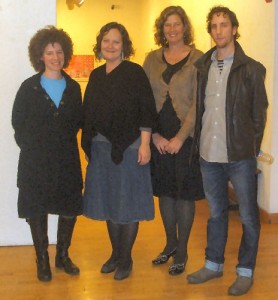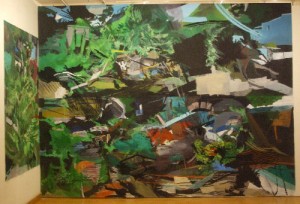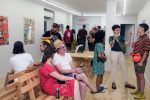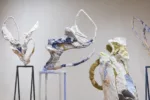The weather on Thursday evening, November 4, could have set the stage for the opening segment of a mystery movie. Instead, the chilly air and endless stream of rain provided a conspiratorial accompaniment to the appropriately titled Wind Challenge Exhibitions at Fleisher Art Memorial, on view through November 20. Although the title was grounded in a far more practical origin than the elements – the surname of its principal funders, Dina and Jerry Wind – it added a touch of irony to the bedraggled guests that trickled in for the gallery talk at Fleisher that night.

Sue Spaid, an independent curator and arts writer, began the evening’s discussion on the colorful splashes and sweeping brushstrokes that comprise the paintings of Arden Bendler Browning. The artist elaborated the process that inspired the clashing forms and disorienting images that populate her pieces. Beginning with snapshots and memories of her travels throughout Philadelphia, as well as the handy supplementation of Google Maps images, Browning constructs a fragmented image of varied urban landscapes. Fascinated as she is by the city’s juxtaposition of beauty with decay, the new with the rundown, her works display these pieces of the city “bumping up against each other.” Browning continues this theme in the arrangement of the works themselves on the glaring white gallery walls: they crowd together in corners or hang slightly off-center in a deliberate attempt to disorient the viewer.
Within these paintings, Spaid saw a world of “roads buckling and bridges collapsing.” Amidst the chaos of form, she detected a warning of a future earth that mankind can no longer inhabit. But for Browning, this chaos represents a time-lapse version of the cityscape that is undefined and obstructed, just as in the experience of everyday urban life. Nevertheless, it seems that the visions of both artist and curator can meet in a happy medium: perhaps the ‘future’ that Spaid saw can be explained by Browning’s subtle acknowledgment of a Googlized reality, where information overload can sometimes leave us spinning.

Accompanied by the squeaking sound of rain boots against the wooden floor, our group was next ushered into the room containing the photographs of Amy Stevens. Stevens’s pictures feature cakes that she has baked herself, centered over backgrounds populated with bright fabrics, scarves, napkins, and cushions. Influenced by vintage shopping and the atmosphere of the 1950s, Stevens bakes, decorates, and photographs dozens of cakes with the intention of critiquing the seasonal world of the women’s magazine. For Spaid, these pictures encompass “identity, celebration, and nostalgia.” Within each cake, she finds a different character cast in its own unique role.
“I can bake cakes that taste good but don’t appear good, and cakes that look good but don’t taste good. Never both,” Stevens remarked, when asked for edible samples of her work. It was a revelation that seemed oddly appropriate. This inability for the worlds of artistry and baking to merge within her pieces seemed like a subconscious reflection of her wish to comment on the hollowness of the life of the proper hostess. While the cakes may seem perfect in the fictional reality created within the photographs, the illusion quickly loses substance when challenged by the curious intrusion of a cake knife.

Fleisher’s dimly lit back room housed the last of the three Challenge exhibitions: Matthew Thomas Cianfrani’s collection, consisting of thin silk photographs framed on steel. Images of skyscrapers taken during his travels graced the gray worlds of his pieces, which according to the artist emerge from the desire to reject the traditional notion of photography as an art form. Existing simultaneously as a denial of the camera’s ability to represent truth and a socioeconomic commentary, Cianfrani’s works project a personal, more spiritual reality.
Spaid was quick to bring up the question of how viewers can be expected to relate to the “faux memories” that exist within the prints. But perhaps the answer lies in the existence of the works themselves. Cianfrani has taken the first step toward making his reality universally relatable: by creating silken replicas of his inner perceptions and displaying them to the public. If eyes are the windows to the soul, then perhaps photographs, in the hands of a discerning artist, can become the windows to reality.

Wind made one final whimsical appearance that evening: in the form of the whirlwind force of Sue Spaid, whose effervescent energy served to provide a link among the three rather disparate artists. Arriving several minutes late and then leaving early for a flight to Las Vegas, Spaid’s breathless enthusiasm and piercing questions led both artists and guests on a tour of social decadance and historical identity that made travelling beneath rain-soaked skies well worth the effort.
“My goal is to make everyone think about things they wouldn’t normally think about,” Spaid remarked over the course of the talk. These words proved true in unexpected ways, when I learned that sometimes friendly, animated discourse can supply the best distraction from a gloomy winter storm.









